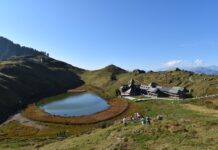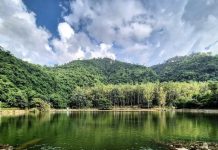Himachal is known for its culture, traditions, and food which vary from District to District. The variations are due to geographical and climatic conditions, as well as the way the food is prepared. Although the everyday meal of Himachal is simple like ‘dal-chawal or sabzi-roti’, yet the food prepared during festivals, marriages or during religious & social celebrations/occasions (birthdays, anniversaries and retirements) has very special significance and importance. One of these special foods is called “KANGRI DHAM”.
History of Dham: It is said that the kings of Chamba were the ancestors of Kusha who was one of the two sons of Lord Rama. With the passage of time, Raja Meru came from Ayodhya and conquered the mountainous city of Chamba. It is believed that the King Jaisthambh who was one of the ancestors of Raja Meru, liked Kashmiri food (one of the neighboring state of Himachal) so much, such that, he wanted to bring these dishes to Chamba with a condition that dishes should be strictly vegetarian as these were to be offered to local Deity. The cooks of King Jaisthambh prepared these dishes with local crops, ingredients, and spices; as a result of the dishes so prepared were different. The uniqueness of the style of cooking led to the creation of the meal known as Dham. It is believed that initially Dham was served only in the temples as Prasad, but now the meal is made for other occasions also. From here concept of Dham spread to the remaining districts of Himachal. As of now, the Dham prepared in Kangra district known as KANGRI DHAM is most popular.

Kangri Dham:
Preparation: A temporary kitchen is built near the compound of the house, that is hosting the Dham. A 6 feet X 9 inches canal is dug in the ground and erecting bamboo sticks serve as the pillar for the steel sheets roof for the kitchen. Dham is cooked only by a particular caste of Brahmins called ‘Boti’ and is typically cooked in mustard oil. The preparation for Dham begins one night before the main occasion like collecting and cleaning the vessels, accumulation of all the grains, pulses, vegetables, spices, and ingredients to be used in the dishes. Firewood is used as fuel to cook the food. The Boti firstly, worship the cooking place, and then, cook the food barefoot wearing dhotis. No one is allowed to enter the kitchen with shoes or chappals on, to avoid germs and dust to enter the kitchen. This is the traditional method of the cooking meal.
The dishes are cooked in the large pot-shaped brass vessels with narrow openings popularly known as ‘Baltoi’, which helps in keeping the dishes warm, and also adds a particular flavor to them. The ‘Khatta’ dish is prepared in a special iron utensil called ‘Kadhai’.
Serving the Meal: Food is served to the people who sit in parallel rows on the ground called ‘Painth’. This signifies brotherhood among the people irrespective of their status. The food is served by Botis barefoot on special plates made out of leaves called ‘Pattals’. These plates are made with the leaves of sal or banyan tree, which are weaved together with the help of small sticks of bamboo wood and are also biodegradable. The entire meal consists of about 10-12 dishes and includes vegetarian food like only lenticels and dairy products. The food is ‘Satwik’ which means no ginger, garlic or onion is used to prepare the dishes. The gravy of the dishes is prepared in curd, which helps in better digestion.

Dishes served in the Dham:
The typical menu of Dham consists of plain white ‘rice’.
Firstly, ‘Madrah’ is served which consists of chhole i.e. chickpea. The gravy of madrah is prepared by cooking yogurt in ghee until the consistency is thick, followed by the addition of many spices.
‘Telia Mah’ is served, which is cooked mainly in mustard oil. The dal is given a special treatment called ‘Dhuni’, in which the mustard oil is put over a piece of burning coal, and then it is immersed in dal. The dal is covered by the tight lid for some time so that it gets the smoky flavor.
With the Telia Mah, ‘Khatta’ is served, which is made by putting Amchur and a powder made of roasted walnuts in it. It is said that khatta helps in removing the fats of madrah made in pure ghee.
It is then followed by rajmah, mutter paneer, and kadhi cooked with buttermilk and pakora. The next dish served is ‘Sepu Vadi’. The dish consists of small white lentil dumplings, which are boiled in water and then deep-fried in mustard oil, then cooked in spinach gravy. In addition, Chana dal, Ohri mungi dal and mithri are also served.
In the end, ‘Meethe chawal’ is served as a sweet dish which is prepared in desi ghee, sugar and saffron. Some dry fruits are also added in the meethe rice to enhance the flavor of the dish.
It is the tradition that after finishing the food, everyone has to get up together to wash their hands, to give respect to everyone eating. The Kangri Dham is so special, delicious and mouth-watering that people wait for months to get the taste again.


















![Himachal Day: Read All About Himachal Pradesh day [15 April] Himachal Pradesh Day - BeingPahadia](https://www.beingpahadia.com/wp-content/uploads/2025/02/Himachal-Pradesh-Day-BeingPahadia-218x150.png)




![Sidh Baba Balak Nath Shahtalai Temple in Deotsidh [Guide] Baba Balak Nath Temple Deotsidh](https://www.beingpahadia.com/wp-content/uploads/2023/04/Baba-Balak-Nath-Temple-Deotsidh-e1681616986690-100x70.jpg)

